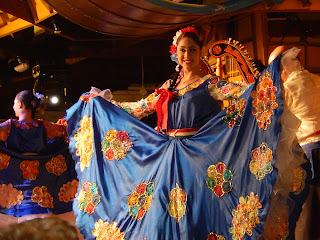One last full day! :( We started the morning by exploring Chapeco's culture and history. At the Museu de Historia e Arte de Chapeco (the Archaeological & History Museum), which was originally the City Hall. In the first room, we saw artifacts discovered at the base of the Uruguay River, found by farmers. These artifacts included funeral pots, tools, and other assorted items. The next room held pieces by two ethnic tribes: the Kaingang and Guarani. The Guarani specialize in wood carvings, and the Kaingang do weavings. From there, we learned more about Chapeco as a modern city; it was built on a grid system after WW2 as a planned city, and the museum showed the city's development from colonization and founding to modern day. Upstairs exposed us to one of Brazil's current passions, the city's football club - Chapecoense - which is celebrating their 40th anniversary; in that time, the Catariense team has won 4 state championships. The museum also showcases the work of local artists, including Agostinho Duart, Cyro Soswoski, Paulo De Siqueira, and Vanderlei Zaminan.
 |
| Funeral pots |
 |
| Ancient tools |
 |
| Woven baskets |
 |
| The evolution of the soccer jerseys |
 |
| 2013 champions! |
Next, we headed to the Museu da Colonizacao de Chapeco, which is a historical house built in 1921. It was originally the city home of an Italian family who came from the state of Rio Grande del Sul. The exhibits here paid homage to the three main industries of the area: erva mate tea, wood, and agriculture.
From there, we went to Cidade do Idoso (Senior City). Cidade do Idoso is a free community for Chapeco's senior citizens over 60 years old, and it has the capacity to serve 1,500 seniors from Chapeco's municipal area. It offers many different outlets, including culture, sports, health, education, and social services. For some, the food they eat at Cidade do Idoso might be the only complete meal they eat that day, and the exercise they receive (gym, pool, dance, pilates, hydrotherapy) is prescribed by one of the doctors on site. In addition to physical health, the program also serves to combat many seniors' worst problem - being alone.


After a morning learning about Chapeco, it was time for the city to learn about us. We were invited to a local TV station where we were shocked to discover we would be interviewed, live, on the television show Ver Mais! The show's host is a Rotarian, and he started the program by interviewing Nora and Darci; then he turned his attention to us. EEEK! Luckily, he tossed us some easy questions, and we made it through relatively unscathed and unembarassed.
 |
| Somebody's going to let these two on TV? |
 |
| And these two jokers? You must be kidding! |
 |
| Nora and Darci being interviewed |
That evening was our final Rotary meeting, presentation, and banner exchange. Tomorrow, we will pack our bags for the last time (somehow!) and head to the airport for our four flights back to Charlotte. It's amazing the wonderful friends and memories that we've made through this program, and I can't believe that a month has gone by so quickly! Our lives are forever changed, and we are incredibly lucky to have been a part of this experience together. Thank you to everyone we've met over the last month, who's showed us the wonderful offerings of Santa Catarina, who has hosted us, translated for us, EVERYTHING. We are forever grateful. And friends and family - we're coming home!
 |
| Our final presentation |
 |
| The team with Fabio and Cintia |
 |
| Emilee and her host dad |
 |
| Here come the tears - Erin & Claudia |
 |
| Paolo and Ana |
 |
| Lu, Nora, and Ana |
 |
| The trouble twins |
 |
| Tchau, Brazil! |
































































